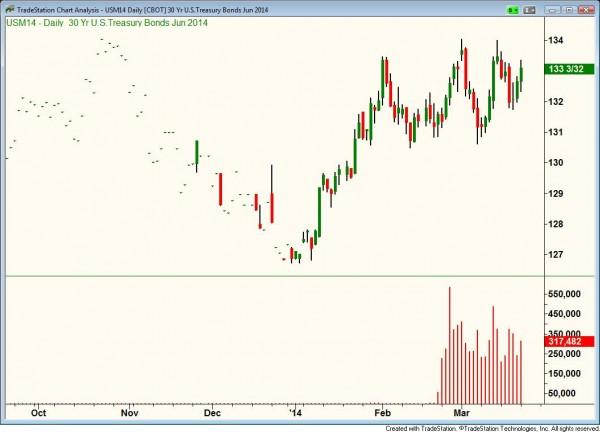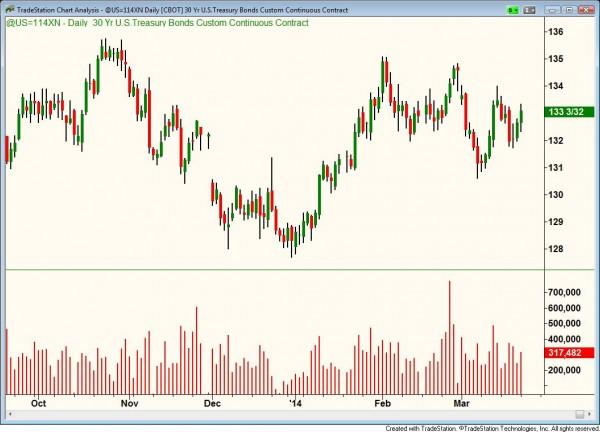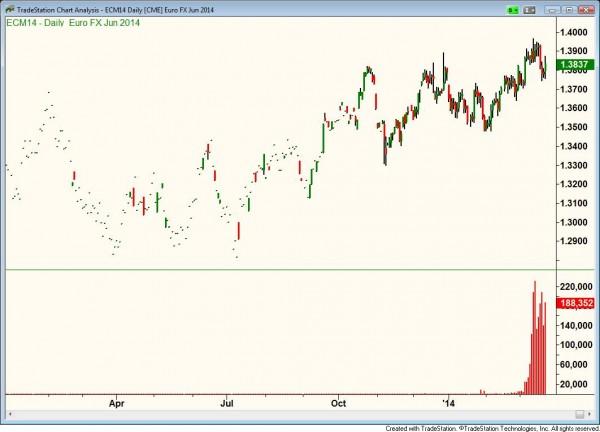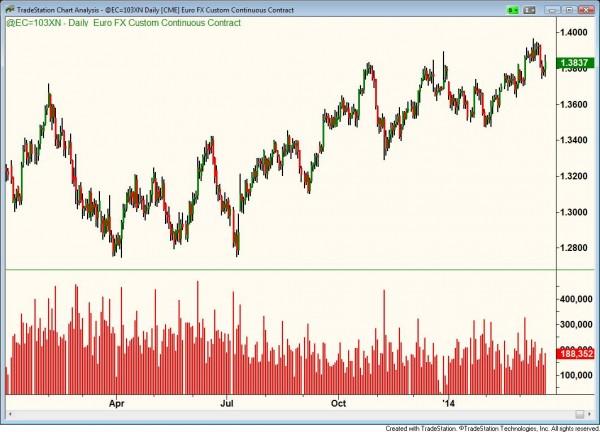Well, maybe we don’t have to take it to this extreme. But if there is one thing I wish the Futures industry would do is that they would standardize the charts we use to make our trading decisions. So much confusion comes from having so many types of charts available to Futures traders:
Un-Adjusted Continuous Charts
Adjusted Continuous Charts
Contract Specific Charts
Contract Specific Continuous Charts
Regular Trading Hours (RTH) Charts
All Session Charts
And the list goes on into the intra-day charts that are available to Futures traders.
The Equity and Spot Forex markets have some of the best looking and straight forward charts in the investing community. In all fairness to the Futures industry these other asset sectors do not have contract expirations to deal with. Until the brains of the Futures industry come up with this type of chart I guess we will have to work with what charts we have.
I received an email recently from a student asking about which chart to use around rollover time. While there have been previous articles written on this topic I thought another article about the Financial Futures markets charts would be helpful to clear up any confusion.
Most new Futures traders gravitate to the Financial Futures contracts when they first start trading Futures. These contracts include the Stock Indexes, Interest Rates and the Currency Futures. Once the new trader understands these instruments then they gradually start to trade the physical Commodity Futures contracts.
Some of the benefits of trading Financial Futures first are:
1. Almost 24 hours of trading during the week
2. Contract expiration months are all during the same period (March, June, September & December)
3. The same economic reports that impact Stock prices typically impact the Financial Futures markets as well
4. Liquidity during the night session is better and reduces the amount of slippage when your protective stops are triggered
The next thing to figure out is which chart to use while trading these vehicles?
My answer has been and always will be, it doesn’t matter as long as you use the same type of chart for “all” of your analysis. The last thing you want to do is use different charts for your analysis. I have seen many times when Futures contracts rollover traders want to switch their chart types temporarily around this time. I personally think this is a big mistake.
From a personal preference I always use un-adjusted continuous charts for all of my Financial Futures contracts. There is never a time when I use a contract specific chart (example USM14, ESM14 etc.) when trading Financial Futures. Of course this is just my personal preference and each trader needs to define their own style.
Some of the reasons I have chosen this style are due to the length of the contract life. All Futures contracts have a First Trading Day (FTD) and a Last Trading Day (LTD). The difference between these two dates is the life of the contract.
Physical Commodity Futures have much longer life of contract times. For example Crude Oil trades for about 6 years before expiring, Corn trades for 3 years before expiring. During this time there is a lot of Commercial trading activity in each contract even before it becomes a near month with the highest volume traded contract.
Financial Futures on the other hand only trade for 1 or 2 years before expiring. The mini S&P trades 2 years, Euro Currency trades 2 years and the 30 Year Treasury (US) market only trades for 1 year. As if the short life of contract is not bad enough the majority of the volume traded in these contracts is done in the near month (approximately 95% of entire volume for all contracts).
With little volume being traded in the forward months the charts do not have full bodied candles and a tremendous number of gaps each day. The volume finally comes to the contract during the last 3 months of the life of contract. This makes using a contract specific chart very difficult to create our supply/demand levels.
Figure 1, 30-Year Treasury market, illustrates the poor chart quality until the last 3 months of the contract life. Notice how the volume expands during the last 3 months of the contract life. This type of chart is referred to as a contract specific chart.
Fig 2 is a chart of the same 30-Year Treasury market using an un-adjusted continuous contract setting. Notice how the volume is consistent across the chart. This is because the software only plots the near month with the most volume when plotting un-adjusted continuous charts.
Figure 3 is a contract specific chart of the Euro Currency. This chart also displays the low volume of the contract until the last 3 months of the life of the contract, making this chart difficult to create supply/demand levels as well.
Figure 4 is an un-adjusted continuous chart of the Euro Currency contract. Again notice how the volume is consistent across the chart.
Around contract expiration traders that normally use un-adjusted continuous charts for some reason want to switch to contract specific charts. There are a host of problems this could cause.
The longer term trend can be in two different directions depending on the chart you select
If the market is at life of contract highs or lows you will have no supply/demand levels to your left
Using contract specific charts soon after a rollover and looking left will give you different supply/demand levels than the un-adjusted continuous chart on the same dates
All of these lead to inconsistent analysis of the market you are trading in. Most traders do not trade markets that are in the process of rolling over from one contract to the next. They will usually skip about 2 days and come back to this market later when everybody is looking at the same charts. There are so many cross currents in the price action around contract rollovers that most traders are better off to sit on the sidelines or trade another market that is not rolling over.
“Don’t go through life, grow through life” Eric Butterworth
This content is intended to provide educational information only. This information should not be construed as individual or customized legal, tax, financial or investment services. As each individual's situation is unique, a qualified professional should be consulted before making legal, tax, financial and investment decisions. The educational information provided in this article does not comprise any course or a part of any course that may be used as an educational credit for any certification purpose and will not prepare any User to be accredited for any licenses in any industry and will not prepare any User to get a job. Reproduced by permission from OTAcademy.com click here for Terms of Use: https://www.otacademy.com/about/terms
Editors’ Picks
EUR/USD edges lower toward 1.0700 post-US PCE

EUR/USD stays under modest bearish pressure but manages to hold above 1.0700 in the American session on Friday. The US Dollar (USD) gathers strength against its rivals after the stronger-than-forecast PCE inflation data, not allowing the pair to gain traction.
GBP/USD retreats to 1.2500 on renewed USD strength

GBP/USD lost its traction and turned negative on the day near 1.2500. Following the stronger-than-expected PCE inflation readings from the US, the USD stays resilient and makes it difficult for the pair to gather recovery momentum.
Gold struggles to hold above $2,350 following US inflation

Gold turned south and declined toward $2,340, erasing a large portion of its daily gains, as the USD benefited from PCE inflation data. The benchmark 10-year US yield, however, stays in negative territory and helps XAU/USD limit its losses.
Bitcoin Weekly Forecast: BTC’s next breakout could propel it to $80,000 Premium

Bitcoin’s recent price consolidation could be nearing its end as technical indicators and on-chain metrics suggest a potential upward breakout. However, this move would not be straightforward and could punish impatient investors.
Week ahead – Hawkish risk as Fed and NFP on tap, Eurozone data eyed too

Fed meets on Wednesday as US inflation stays elevated. Will Friday’s jobs report bring relief or more angst for the markets? Eurozone flash GDP and CPI numbers in focus for the Euro.
RECOMMENDED LESSONS
Making money in forex is easy if you know how the bankers trade!
Discover how to make money in forex is easy if you know how the bankers trade!
5 Forex News Events You Need To Know
In the fast moving world of currency markets, it is extremely important for new traders to know the list of important forex news...
Top 10 Chart Patterns Every Trader Should Know
Chart patterns are one of the most effective trading tools for a trader. They are pure price-action, and form on the basis of underlying buying and...
7 Ways to Avoid Forex Scams
The forex industry is recently seeing more and more scams. Here are 7 ways to avoid losing your money in such scams: Forex scams are becoming frequent. Michael Greenberg reports on luxurious expenses, including a submarine bought from the money taken from forex traders. Here’s another report of a forex fraud. So, how can we avoid falling in such forex scams?
What Are the 10 Fatal Mistakes Traders Make
Trading is exciting. Trading is hard. Trading is extremely hard. Some say that it takes more than 10,000 hours to master. Others believe that trading is the way to quick riches. They might be both wrong. What is important to know that no matter how experienced you are, mistakes will be part of the trading process.




